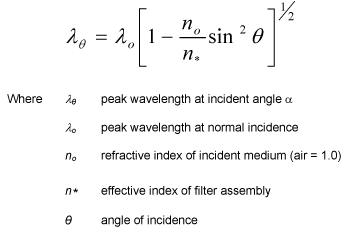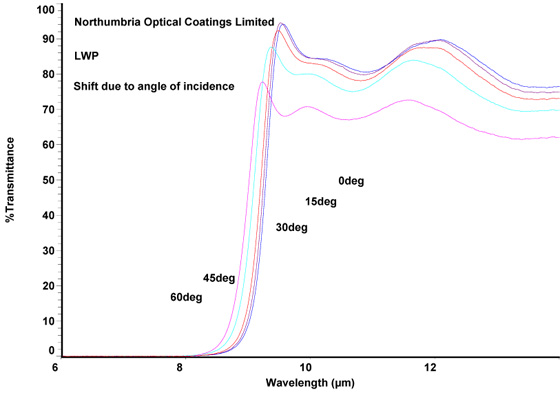Optical Infrared Interference Filters
IR Filters: 1.5 – 20μm
Angle of Incidence Effects and “Tuning”
Due to the construction of interference filters, a shift to shorter wavelengths occurs if the angle of incidence varies from normal. At small angles this shift can be very useful in tuning a filter to a desired peak wavelength but larger angles (30 degrees or more) can cause a fall in transmittance and distortion of the band pass shape. The shift in peak wavelength can be estimated using the following formula (which is valid only for collimated light with incident angles less than 10 degrees).
The effective index of a filter depends on the materials used in the construction. NOC filters have typical effective indices (n*) ranging from 1.7 to greater than 2.5.
Filters used in uncollimated light
The above relationship is valid only for collimated light. When a filter is used in a converging or diverging beam the changes are much more exaggerated and result not only in a central wavelength shift but also in a broadening of the bandwidth and a reduction in peak transmittance. For semi-cone angles up to 5° these changes are negligible. For angles above 5° the shift in peak wavelength can be estimated by substituting the semi-cone angle into the above equation and halving the resultant shift. It should be stressed, however, that the above formula should only be used as a guide. Accurate results are best obtained by actual measured values to confirm the peak wavelength shift with angle of incidence for any particular filter.
Typical Performance
The curve of an actual narrow band filter shows how the transmittance and shape of the filter are affected by the change in incident angle.
This change in transmittance can also be observed with edge filters, for example an actual long wave pass curve.
The degree of change in transmittance or shape of the filter is dependant upon the design used to produce the coating. Therefore, accurate results can only be obtained by measuring actual filters.
Northumbria Optical Coatings Ltd (NOC) was established in 1995, specializing in the design and manufacture of Infrared Optical Filters and Coatings, covering the spectral range 1.5μm – 20.0μm. Before 1995 NOC operated as a business unit for Rolls Royce International Research & Development based in Newcastle upon Tyne. NOC offers competitively priced standard and non-standard filters which are used in many applications including environmental monitoring, analysis and control of gaseous effluent, analysis of vehicle exhaust gases, ozone layer monitoring, night vision systems and space applications. Contact EOC for more information.


